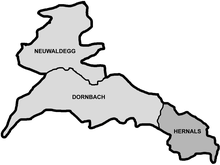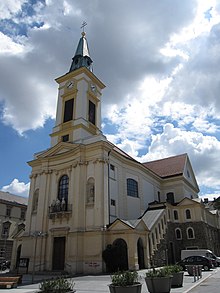Hernals (district of Vienna)
| Hernals | |
|---|---|
| coat of arms | map |

|

|
Hernals is a district of Vienna in the same 17th district of Vienna Hernals and one of 89 Vienna Katastralgemeinden . The place was an independent municipality until 1891.
geography
The Hernals part of the district is located east of Dornbach in the east of the municipality. In the north, Hernals borders on the districts of Gersthof and Währing in the 18th district , in the east on the districts of Alsergrund and Josefstadt on the other side of the Gürtels and in the south on the district of Ottakring in the 16th district . The Hernals cadastral community covers an area of 195.34 hectares , making it the smallest of the Hernals districts.
history
Origin of name
The name Hernals is derived from a family of knights, the lords of Als. The Als is in turn the longest Wienerwaldbach after the Wien River . The origin of the word Als allows for different interpretations. Linguists derive the word from the Old Slavic word Olša , Erlenbach, and from the Celtic word for Bach, old , with the t hissing.
Antiquity
Hernalser Boden was already in use under the Romans, as the Roman stones from Hernals prove.
Hernals in the Middle Ages
The first documented mention of Hernals comes from the year 1044, when Sighard the IV., Count of the Salzburg and Chiemburggau, gave the St. Peter monastery in Salzburg "two noble heads [housed farms] on the Als". These two noble heads are assumed to be the original settlements of Hernals and the neighboring Dornbach. One of the "noble hats" came as a fief to the lords of Als, a respected knight family. The court of the Lords of Als originally stood on a hill facing south (around the current location of the Kalvarienbergkirche) and was surrounded by a moat and a circular wall. A pastor and a Bartholomew altar in Herrenals were first mentioned in 1252 and 1301, respectively. A few noble estates and the huts of the serf farmers gradually became a small village. The core of the settlement was again on the Nesselbach and on a narrow strip between the Als and Dorfstrasse (today Elterleinplatz to Veronikagasse). The commercial operations that belonged to the Association of Viennese Guilds also settled here . In 1395 the noble family of Roggendorfer was enfeoffed with the rule of Hernals by Duke Albrecht IV .
Hernals at the time of the Reformation

At the beginning of the 16th century, Hernals changed hands again. In 1515, Hans Geyer zu Osterburg acquired a fiefdom from Emperor Maximilian I Hernals . The first Turkish siege of Vienna hit the town of Hernals hard. On September 27th, 1529 the village and church were destroyed by flames, the surrounding vineyards were destroyed by the Turks . Since the resident pastor found no support, he converted to Protestantism . The Geyer family also turned to the new faith after Maximilian refused the request to leave the fiefdom to them as free property after the destruction . Ferdinand Geyer sold Hernals in 1587 to Wolfgang Jörger zu Tollet and Köppach, but without the feudal consent. The Jörger family also intensively promoted Protestantism. The freedom of belief only lasted a short time. After Emperor Matthias Jörger family in 1618 nor later the fief was transferred Hernals, continued after the victory of Emperor Ferdinand II. In the Battle of White Mountain , the recatholicization Lower Austria one. Since Helmert Jörger refused to take the oath of homage to the emperor, he was arrested and sentenced to death in 1622. His possessions were handed over to the cathedral chapter of Sankt Stephan , Jörger was pardoned in 1625 and expelled from the country.
Hernals under the cathedral chapter
With the end of the Reformation-minded feudal lords, the Counter-Reformation began with full vigor . As a sign of the victory of the Catholic faith and in the service of re-Catholicization, a Passion Trail was laid out and opened in 1639. Due to the destruction of the place during the second Turkish siege of Vienna in 1683, viticulture lost its importance compared to agriculture and in the 18th century the character of the place changed to a garden village with vineyards and pleasure gardens. Around 1800, Hernals became a popular summer resort for the Viennese bourgeoisie, who gradually ousted the aristocrats. But Hernals also became important for the water supply of Vienna . As early as 1565, the city of Vienna was allowed to lay a water pipe in wooden pipes through Hernals to the city wall. In 1732, due to the increasing demand for water, the main source of the Als was included in the pipeline. As a result, the stream once rich in fish lost a lot of water and the Hernals mill had to be closed. The pollution of the brook brought a great risk of epidemics, after a Danube flood in 1830, the backflow of the Als led to a cholera epidemic. Then the brook was arched within the line wall . After further cholera epidemics, the Als was finally built in Hernals from 1877 onwards.
Hernals from 1848

After the closure of the Josefstadt theater, the “First Vienna National Arena” was opened in Hernals in 1848, where educational plays were shown to great public interest .
After Metternich's fall , a national guard was also set up . However, this dissolved when the imperial troops set up camp between Hernals and Dornbach .
Industrialization changed the formerly small village radically. Already at the turn of the 18th to the 19th century, the first large commercial enterprises settled in Hernals. Nevertheless, the place had only 146 houses with 2,680 inhabitants in 1820. By 1883, however, the number of Hernalsers exploded to 60,307 people. At that time, Hernals was the third largest municipality in Austria after Vienna and Graz . Immigrants from all over the monarchy poured into Vienna and the neighboring suburbs. At this time the interest barracks were built and Hernals expanded further and further west.
In 1865, Hernals was connected to Vienna by a horse-drawn tramway , and a year later it was extended to Dornbach. In 1883, Hernals was also the first Viennese suburb to have its own town hall , which today houses the municipal district office. From 1868 to 1891, Hernals was the seat of the Hernals District Commission .
Incorporation
After the suburbs of Vienna were incorporated in 1850, the discussion about the incorporation of the suburbs began in the 1870s. However, almost all of the suburbs were against the proposal. However, at the request of Emperor Franz Joseph in a speech in 1888, the Lower Austrian provincial committee decided to unite Vienna with the suburbs. A corresponding law came into force on January 1, 1892 and united Hernals, Dornbach and Neuwaldegg to form the 17th Viennese district of Hernals.
For the history of Hernals after the incorporation until today see Hernals .
Religion and sacred buildings
Bartholomäuskirche and Reformation in Hernals
Documented mentions of the Hernals church only go back to the 12th century. The founding of the Bartholomäuskirche in Hernals is dated before 1252. It was expanded in 1471 and demolished in 1784. Hernals first achieved religious significance through the Reformation . Since the resident pastor Georg Schwaiger found no support after the church was destroyed by the Turks in 1529, he converted to Protestantism. The feudal families Geyer and Jörger also supported Protestantism. From 1542 Lutheran preachers worked in Hernals . People also flocked from Vienna to the fair in Hernals, at times up to 10,000 believers gathered. Therefore the Hernals church was closed in 1577 by Emperor Rudolf II . In 1609, however, the Jörger again introduced the Protestant church service in Hernals. After the eviction of the Protestant liege lord, a way of the cross was built at the suggestion of the Jesuit father Karl Mussart . This led from St. Stephan to Hernals and was in 1639 with a procession that was led by Emperor Ferdinand III. was personally cited. However, in the course of the second Turkish siege of Vienna in 1683, the village, the parish church and large parts of the stations of the cross were destroyed. The Bartholomäuskirche was demolished in the 1880s and its function was taken over by the new Kalvarienbergkirche.
Calvary Church

In memory of the Stations of the Cross, a calvary was built by the wealthy, respected Viennese citizens . In 1709 it was piled up in the immediate vicinity of the Hernals parish church. Seven small chapels on the theme of "Jesus atoning for the main sins" or the virtues were built along the two paths up the hill . A crucifixion group with 14 carved reliefs was erected on the hill itself . In addition, a small church was built in 1714. Since the small sanctuary quickly became dilapidated, the preaching there erected Paulines - monks , the Calvary Church , which was inaugurated 1769th As the Kalvarienbergkirche became too small again in the 19th century due to the growth of the Hernals parish church, Mayor Elterlein founded the Hernalser Kirchenbauverein in 1882. The renovation began in 1892 according to plans by Richard Jordan , which was completed in 1894. The church was enlarged so that only the front baroque part remained. The crucifixion group was housed in a domed room. After bomb damage in World War II , the repair of the church lasted until 1965, between 1990 and 2000 it and the Calvary were completely renovated.
Hernalser Friedhof
The Hernals cemetery was originally located near the parish church on Bartholomäusplatz. However, by a decree issued by Joseph II in 1784 , the cemetery had to be located at the end of the village. The cemetery was then moved to Lorenz-Bayer-Platz. When the space there turned out to be too small, the cemetery was rebuilt between 1870 and 1872 on Alsrück. The neo-Gothic chapel and the arcaded tombs running in three lines are significant .
Economy and Infrastructure
The only livelihood for the people of Hernals was originally viticulture . This livelihood was destroyed by the first and second Turkish sieges of Vienna in 1529 and 1683, respectively. In addition, the lack of workers for the vineyards now had an effect, so that viticulture was replaced by agriculture , also because it promised more yield. It was not until the middle of the 18th century that viticulture was cultivated again in the form of house vineyards.
Around 1800, larger businesses also settled in Hernals. These “factories” had an average of ten to fifteen workers. The Bergegrün factory founded by Stephan Leopold Häckl von Rosenstein in 1785 for the production of verdigris and the trellis factory (for wallpaper ) by Johann Dufrain, which opened in 1797, gained importance. In addition there was the oil refining factory of Count Pálffy and the Hernalser Brauhaus founded by Rudolf Müller in 1839. In the 1860s and 1870s a large number of other factories were added, such as a brick factory , machine factories and the Josef Manner chocolate factory . The main building of the Gersthof Orthopedic Hospital, which was built between 1924 and 1926, is also located in Hernals .
Personalities
- Edmund Eysler (1874–1949), composer
- Alfred Mautner (1886–1945), architect
- Karl Mediz (1868–1945), painter
- Franz Ram (1813–1889), architect
- Alois Schornböck (1863–1926), painter
literature
- Rudolf Spitzer: Hernals: between belt and Hameau . Mohl, Vienna 1991, ISBN 3-900272-39-5
Coordinates: 48 ° 13 ' N , 16 ° 19' E

